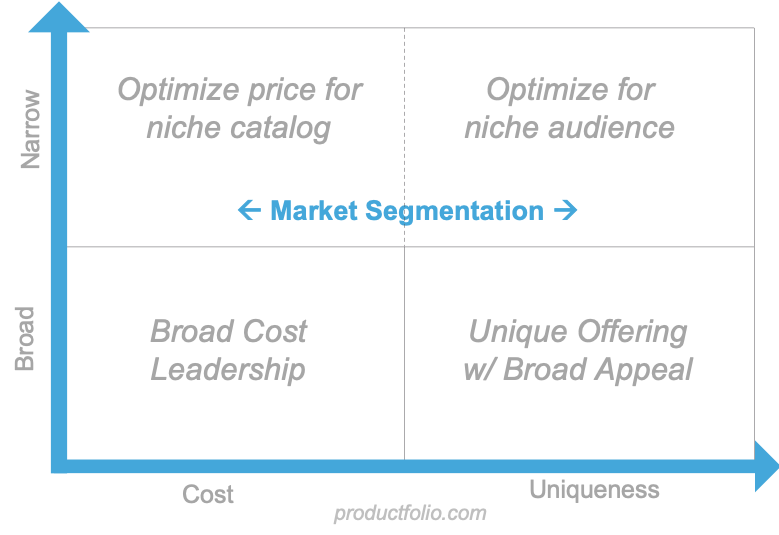Harvard Professor Michael Porter spent years contemplating market strategy, eventually writing a book Competitive Advantage: Creating and Sustaining Superior Performance in which he coined the phrase “Generic Competitive Strategy”. After much research, he eventually determined there are only 4 (generic) strategies that a company can take, which he described with a simple 2×2 grid. This is a very helpful framework for product strategy, as you think about market positioning, differentiation, and product vision as examples.

What is a Generic Competitive Strategy?
According to Porter, there are two ways that a company can gain a competitive advantage; cost advantage or differentiation. A company is either working in a broad or narrow range within the core focus of cost advantage or differentiation. Let’s take a look at each strategy:
- Cost Leadership – A cost leadership strategy is applied when a company is able to be a-low cost performer. Things like low overhead, lower rates from venders than what your competitors receive, and lower costs on raw materials. Keeping costs lower than your competitors and charging the same rates as your competitors will give a distinct competitive cost advantage. To maximize a cost leadership position a company can underbid its competitor while still maintaining a healthy profit. A few examples of companies that use the Cost Leadership model are Ikea, Jet Blue, and Walmart.
- Differentiation – In this model a company seeks to be unique as well as valuable to its customers. Often times a company will offer features or services that are not offered by the competition. A company will also go out of its way to be perceived as valuable or like a precious commodity. The uniqueness that a company offers has to be something that its customers are willing to pay a premium price for in order to be successful. Some examples of companies that use differentiation are Apple, BMW, and Tiffany’s.
- Focus – The Focus strategy is best applied when a company is working in a niche market or has a niche that is within the overall organization. Niche markets tend to be smaller and therefore provide the opportunity to develop loyal customers. Within the Focus Strategy, there is the option to focus on either cost leadership or differentiation by adding value to their product and offering it to a select group. Examples of companies using the focus strategy would be Empatica, TOMS and Veggie Grill.
All of the strategies can be broken down into being either broad or narrow in their scope. Cost Leadership and Differentiation are broad, as they appeal to a broad customer base. As examples, Apple and Walmart both appeal to the entire population just in different ways. Whereas a company like Veggie Grill is appealing to a more narrow group of vegetarians and vegans.
Implementing Generic Competitive Strategy
How the chosen strategy is implemented into an organized is the key to its success. It’s imperative that the strategy becomes the core of the company’s culture. For example, if a company chooses cost leadership as the strategy then everyone down the line in the organization must adopt this strategy.. Buyers need to be able to negotiate preferential rates with vendors, even the facility itself must adhere to the low-cost strategy with a low rate lease and cost-effective furnishings. Everyone in the organization has to be ruthless in their pursuit of achieving the lowest rates possible for every line item in the companies budget.
If a company chooses to adopt differentiation as their strategy they will be appealing to a select group of customers that are willing to pay more for their product or service. Because of this, it’s important for the company to know their customers well and offer features and services that are unique and appeal to a need or desire in their select market.
Focus Strategies appeal to specific market segments. Therefore an organization has two options when choosing this strategy; cost focus and differentiation focus. Ideally, a company is focusing on a target market with special needs. Cost Focus and Differentiation Focus are narrow in focus as they appeal to a more select targeted group. For example, Empatica is a watch for people with Epilepsy and TOMS shoes appeal to environmentally-minded which are more narrow target groups.
Why use the Generic Competitive Strategy?
Michael Porter created the Generic Strategy with the belief that all successful companies will adopt one of these strategies. If they do not, they’ll find themselves stuck somewhere in the middle and will ultimately lose out to a competitor that has adopted one of the strategies.